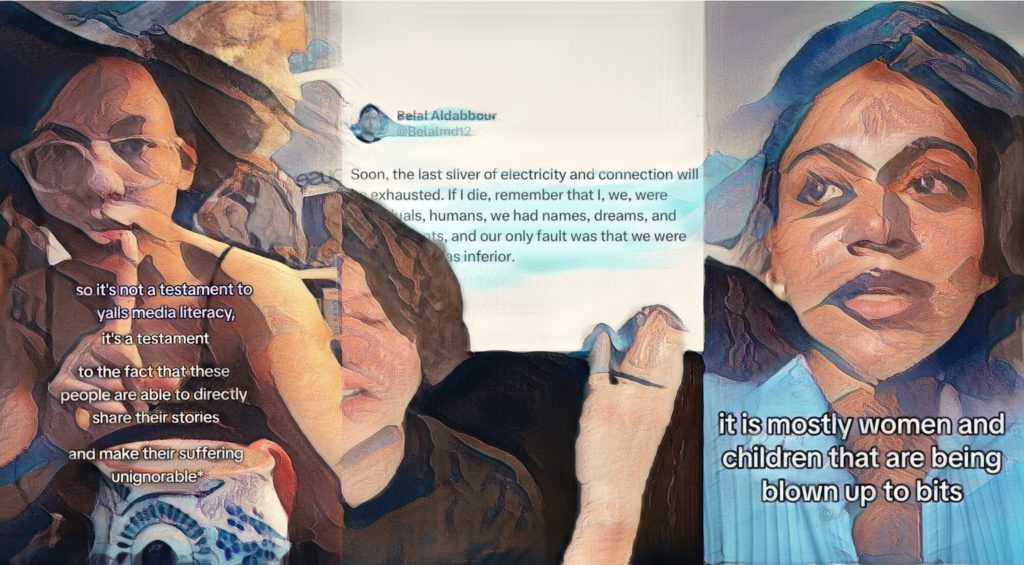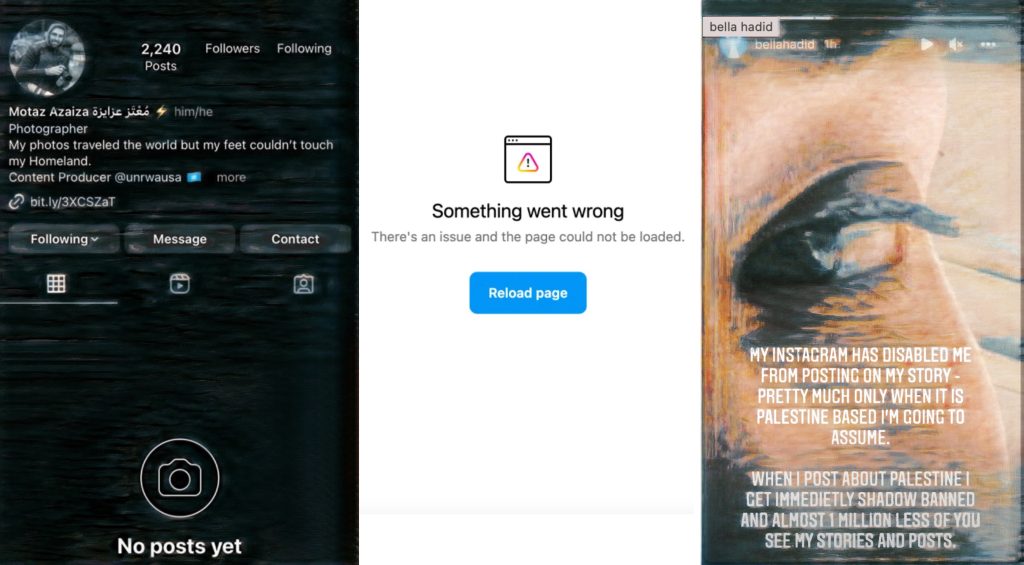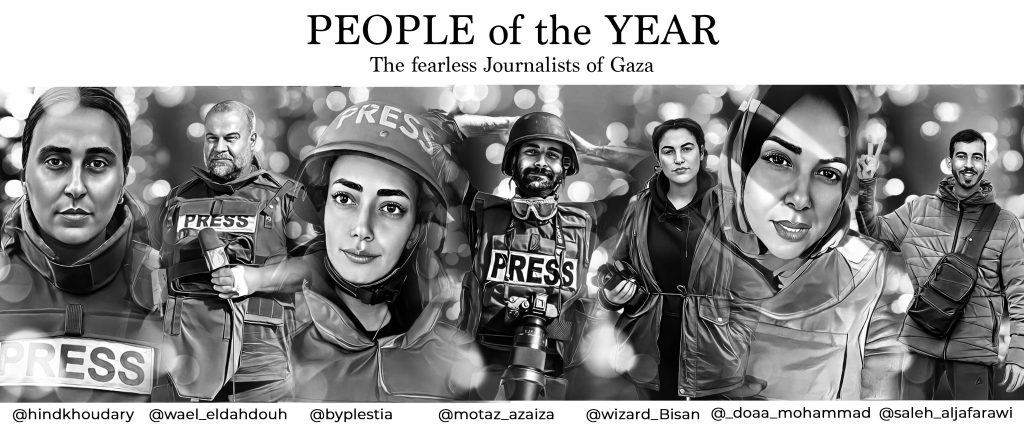The global media landscape has never been in more turmoil than in the past 90 days.
The Israeli offensive on Gaza after the 7th of October attacks accelerated a tectonic shift in the dynamics of news circulation with consequences at multiple scales which will take time to examine and assess adequately.
“We have a TikTok problem” Anti Defamation League Director Jonathan Greenblatt said in a leaked audio file in early November, lamenting the spread of “antisemitic propaganda”. “The issue is not ‘left and right’, it’s ‘young and old”, he continued.
Republican candidate Nikki Haley claimed that watching TikTok made people “17% more antisemitic, more pro-Hamas every 30 minutes”.
A new player emerging in the media narrative wars is “Gen Z TikTok”, a mushrooming, leaderless movement of young people acting as mediators, translators and distributors of news sources, as a response to what they perceive as propaganda and lies spread by mainstream media around the reporting of the relentless attacks on Gaza and the violence in the Palestinian territories and the South of Lebanon.
Young social media users, some of whom have more followers than the most viewed American TV shows, are loudly refusing the narrative that equates them to being terrorist sympathisers for being anti-war, and or equals being anti-Zionist to being anti-semitic.

Disinformation, stereotyping and biassed reporting about Palestinian issues is not news, but the gravity of the recent events, the variety of responses and the stakes at play unleashed a whole new level of concerted multipolar efforts to control the narrative as the war unfolds in real time.
Narrative Control and counter strategies
Several recently published reports by major human rights, media monitoring and transparency advocacy organisations highlight that Meta, Google and X have been systematically censoring pro Palestine content. Users from over 60 countries have flagged these anomalous activities including disappearing posts and account suspensions.
Social media users have been well aware of these tactics, including the widespread practice of “shadowbanning”, a soft censorship tool deployed to de-prioritise sensitive or controversial content without outright banning (which could be subject to legal/corporate scrutiny).

They immediately came up with hacking strategies to circumvent it: from posting selfies, cute pets and “thirst traps” (posts intended to entice viewers through attractive content) with the caption “algo break”, to hiding #IstandwithPalestine hashtags and stickers behind a screenshot, to even including #IstandwithIsrael in their posts, leveraging on the fact that this is the kind of content Meta and other platforms have interest in hyping up, no matter if it doesn’t reflect the users’ views.

Zoomers, or Gen Z, (between 11 and 27 y.o) and, to an extent, Millennials, have learned better and faster than previous generations that rather than public interest, it is the logic and currency of attention and clicks that reflect on the news agenda and on the production of news stories.
Moreover, they are better trained than older generations at spotting the difference between genuine, sound reporting and consensus campaigns. Just to give an example, growing up with someone like Georainbolt, a social media personality specialised in Geoguessr games, casually appearing on your feed, it is likely you will become aware, even if accidentally, of the availability and access to open source high quality satellite imagery and state-of-the-art digital geolocation tools.
Because of this, it will be much harder to convince you that one of the best funded and most technologically advanced armies in the world cannot discern between civilian and militant targets.
Gen Z are often well versed and fast at crafting and packaging multimedia content and thus more capable of detecting propaganda techniques and strategies behind the scene. Coming of age at the peak of neoliberalism, they have learned to be treated as consumers as opposed to citizens with rights, and they are acting accordingly. As reliability, consistency and expertise constitute valuable currency on social media, young people don’t want to get caught as gullible victims of brainwashing (as well as pink and greenwashing).
The Israeli actress posing as an Arab nurse betrayed by her bad accent; the allegedly murdered festival girl found in a clinic; the 40 babies beheaded and baked in the oven; the AI generated pro-IDF marches in Jerusalem; the Israeli teens dressed up as a mockery of injured and bereaved Gazan mothers amid the rubble; the old movies and old war documents framed as original footage of Hamas crimes…are only a few examples of hoaxes and narrative manipulations in operation since October 7th which were exposed on Instagram and Tiktok thanks to Gen Z social media users.

Moreover, we have seen that this spontaneous debunking industry can affect traditional media too.
Every time a piece of propaganda reaches mainstream media exposure, it gets easily ridiculed by an army of stealth content creators, meme wizards and shitposters, accounts specialised in satirical, poor quality content aimed at derailing discussions and, in this case, propaganda.
A recent example is when the BBC mistranslated an interview with a freed Palestinian prisoner. After Respond Crisis Translation, which defines itself as “a collective of language activists”, confirmed the translation was not correct, the following social media shitstorm forced ultimately BBC to give space to a clarification and apology.
In all these cases, it is social media users who are fulfilling the role of a watchdog and media monitoring apparatus that independent / public / supranational institutions would be expected to perform.
If are the kids who are acting like the adults in the room
Throughout the past decade, as social media platforms consolidated their power, legacy mainstream media have either warned of their unreliability as unverified news sources and positioned themselves in opposition of them as external “objective” commentators and guarantors of historical truth, or seamlessly adopted their logic and, once social media critical content goes viral, they eventually cave in to report it as a newsworthy event.
In recent years, in the context of the Israeli-Palestinian conflict, a significant number of underreported stories and the debunking of popular hoaxes forced their way into mainstream media cycles because of their traction on Twitter (now X), Instagram and more recently Tik Tok.
For instance, during the illegal occupation of Sheikh Jarrah in the West Bank in May 2021, viral social media posts documenting the atrocities and expressions of solidarity by ultra famous celebrities such as fashion model Bella Hadid contributed to catapulting the events on the global news agenda.
After 90 days, despite the multilateral (multibillion dollar) efforts in suppressing the circulation of this kind of content, despite “outrage fatigue”, job losses and defamation campaigns, traffic and number of shares are still high.
The dedication of pro Palestine content creators seems to be fueled by both a desire to be part of a community, and by a genuine interest in fighting propaganda and disinformation. The reward that comes with the simple act of sharing is priceless.
What drives users to contribute to fact-checking and news verification to dismantle Israeli propaganda with their time and research skills is not monetary, which makes it much harder to control.
As much as the 40 beheaded babies hoax has accelerated the escalation of the 7th of October attack, theatrical, viral takedowns of the many hoaxes originated from pro-IDF accounts could mitigate the harm by slowly pressuring those responsible for spreading the falsehood, and in turn, pushing politicians and public representatives to acknowledge and retreat.
An example is the viral Tiktok brutal mockeries of the IDF clips showing the “Hamas list”, hilariously debunked as simply showing the days of the week, such as these posts with the caption “did they think 313 million people in the world that speak and read Arabic wouldn’t catch that 💀 #arab tik tok”.

A viral post on Instagram on December 7th portrays the Gaza journalists who rose to fame on social media as Time’s magazine “People of the Year”. Bisan Wisam, Motaz Aziza, Plestia Alaqad, Hind Khoudari, Aboud Batah, Ahmed Hijazi, Saleh Jarafawi, Wael Dahdouh and Yara Eid ended up on the (fake) cover not only because of their courage and professionalism, but also because of how exceptional their popularity is, in a mainstream media ecosystem traditionally cautious in giving space to local Arab sources and reluctant to acknowledge Arab and Muslim journalists and journalistic outlets as impartial.

Yet it is especially traditional mainstream media which has been parroting well documented Hasbara/IDF propaganda and unverified sensationalist news stories, hardly giving any space to corrections, apologies and necessary acknowledgements of their own low standards in the reporting process. The damage has already been done, as the escalation of the war itself has been in part justified by the reports of events that later on have been proven to be fabricated.
Thus, the media logic today appears to have been reversed, and it appears that social media, which before were so associated with fake news or hate speech, are being increasingly called to verify and check on traditional media.
It is perhaps too early (and too optimistic) to see it this way. However, when the logic of clicks and clout, instead of that of professionalism, appears to have fully contaminated the mainstream media economy, there might be hope in young, tech savvy people to help steer these poisoning tendencies.
When veteran middle aged, and mainly white journalists act like embittered teenagers, such as the German newspaper attacking Greta Thunberg for her “opportunistic and woke” support of civilian victims in Palestine, a new array of news verification and counter-propaganda strategies and aesthetics become necessary.
If established public figures in journalism use their platform to intimidate and mock a teenager with Asperger syndrome and to advocate for mass deportations of Arab migrants, the familiar, paternalistic rhetoric of “raising awareness” and “educating the younger generations” to “European values” of coexistence and respect of human rights start to sound jarring.
A fresh addition to the list of young and popular influencers is 9 year old Lama Jamous from Gaza, an aspiring journalist reporting her daily experience of the war in real time.
In a 19th of December post titled “The suffering of people in Gaza” she shares the latest updates. “I will tell you about the suffering of people in transportation where there is no oil for cars. Currently, there are no cars to transport people, so they rely solely on these means to get to their destinations. I want the war to end peacefully, and for us to return to our homes in peace.”
In this climate, in other words, it’s the kids who are acting like the adults in the room.
Reports from Israeli sources point out at the increasing preoccupation of Netanyahu about the growing popular support for the Palestinian cause, which became stronger because of the traction of protests, direct actions, and official condemnation by politicians, UN representatives, celebrities and other public figures.
Without the concerted efforts of a very heterogeneous, loose (rhizomatic?) network of individuals and collectives all over the world, the ubiquitous platforms billions of people connect and communicate through daily are inadvertently facilitating a series of parallel shifts in the quality of dominant media narratives and on the filters through which we read them. OSINT (Open Source Intelligence) is on the rise, and not only as organised platforms but as a distributed and spontaneous practice.
Millions of people follow and believe Bisan, one of the most popular young journalists from Gaza, not because she sounds “objective”, or because her videos are slick and polished, but rather because she is witnessing and experiencing this tragedy on her own skin, without filters, every day, and without the familiar (if uncanny) composure of “impartial” Western news anchors.








